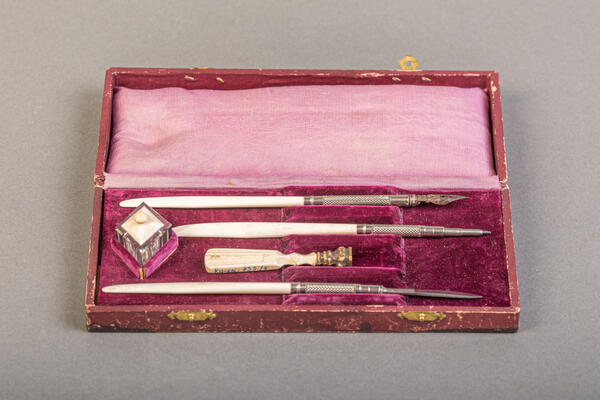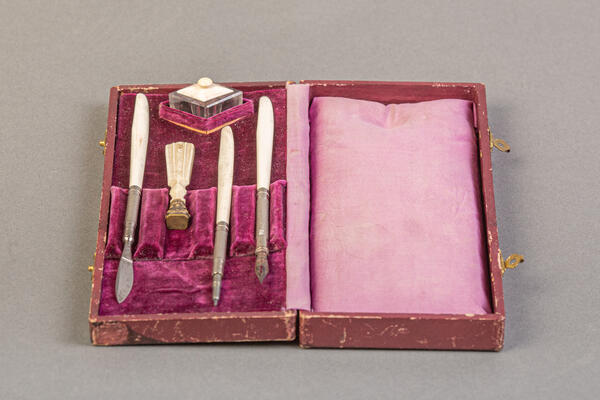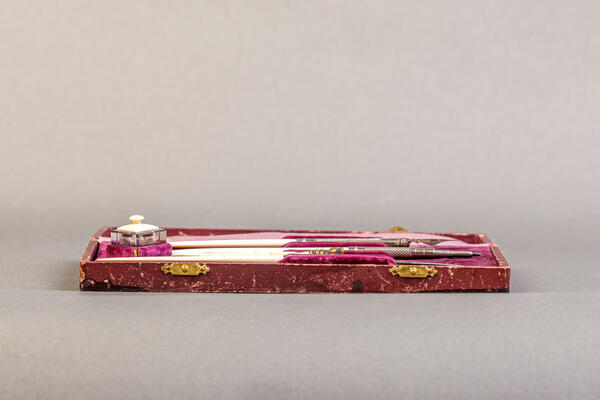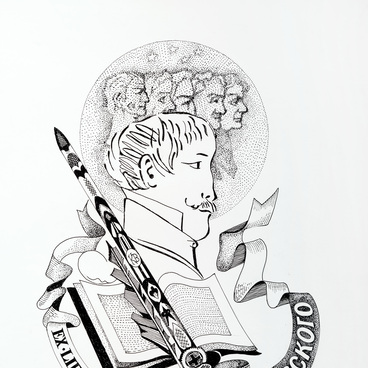In the 18th century, the epistolary genre came into fashion in European high society. Private letters were written not only for the sake of communication but also because it was fashionable at the time.
Since then, the writing set has become an indispensable attribute of the desktop, and craftsmen have striven to transform it from merely a utilitarian object into a real work of art. The cases were made of wood, silver, gold, mother-of-pearl, and tortoise shell, and were inlaid with precious and semi-precious metals, decorated with pearls, covered with enamels or painting, and even decorated with miniature statues, monograms, and coats of arms. Massive or compact, elegant or ornate, they invariably reflected the tastes, personality, and sometimes even the occupation of the owner.
The built-in clock, mirror, and secret drawers made the tabletop design resemble a miniature copy of the secretary.
A person’s culture and social status could be determined by the quality and condition of their writing sets.
Legend has it that the prototype of a fountain pen was invented by a resourceful servant of a writer or an official: the master wrote a lot, and the servant had to sharpen the quill all the time. Having become tired of that, the nameless inventor adapted an iron nib to the tip of the quill. Such a pen often tore the paper, it was impossible to re-sharpen it, besides, there was no slot in it and no airflow. Because of this, the ink was transferred unevenly, and splashes flew in all directions. Nevertheless, the owner was pleased, and the invention came into use.
By the 1830s, metal-nib pens began to replace traditional quills. Instead of low-quality iron, wear-resistant alloys based on gold, osmium, and iridium began to be used for nibs. To emphasize the status of the owner, the barrel was made of precious materials, such as ebonite, silver, gold, ivory, and mahogany.
During travels, compact and tightly sealed sets were used. This box has a velvet pad, with everything a person would need for writing, including a fountain pen, a pencil, a paper knife, an inkwell with an ivory lid and a bronze seal.
Since then, the writing set has become an indispensable attribute of the desktop, and craftsmen have striven to transform it from merely a utilitarian object into a real work of art. The cases were made of wood, silver, gold, mother-of-pearl, and tortoise shell, and were inlaid with precious and semi-precious metals, decorated with pearls, covered with enamels or painting, and even decorated with miniature statues, monograms, and coats of arms. Massive or compact, elegant or ornate, they invariably reflected the tastes, personality, and sometimes even the occupation of the owner.
The built-in clock, mirror, and secret drawers made the tabletop design resemble a miniature copy of the secretary.
A person’s culture and social status could be determined by the quality and condition of their writing sets.
Legend has it that the prototype of a fountain pen was invented by a resourceful servant of a writer or an official: the master wrote a lot, and the servant had to sharpen the quill all the time. Having become tired of that, the nameless inventor adapted an iron nib to the tip of the quill. Such a pen often tore the paper, it was impossible to re-sharpen it, besides, there was no slot in it and no airflow. Because of this, the ink was transferred unevenly, and splashes flew in all directions. Nevertheless, the owner was pleased, and the invention came into use.
By the 1830s, metal-nib pens began to replace traditional quills. Instead of low-quality iron, wear-resistant alloys based on gold, osmium, and iridium began to be used for nibs. To emphasize the status of the owner, the barrel was made of precious materials, such as ebonite, silver, gold, ivory, and mahogany.
During travels, compact and tightly sealed sets were used. This box has a velvet pad, with everything a person would need for writing, including a fountain pen, a pencil, a paper knife, an inkwell with an ivory lid and a bronze seal.






